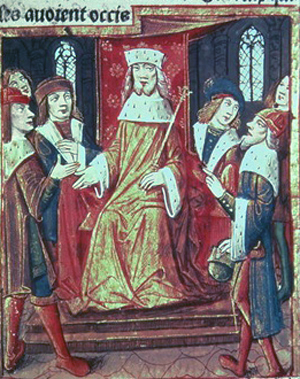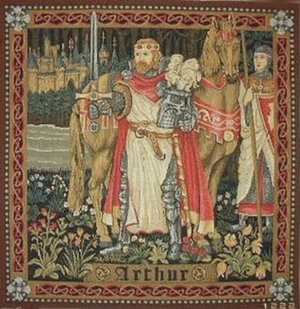 |
Stories & Legends
The Legend of the Ermine of Our Lady
Hugh O'Reilly
The ermine is part of the heraldry of the Duchy of Brittany in France. I go to the chroniclers of old to transcribe the beautiful legend of how the ermine was introduced onto the coat of arms in Brittany, conserving as much as possible the charm and freshness of the original French narrative.
In that time the valiant King Arthur ruled Great Brittany, and I cannot tell you how many giants he chopped in two, how many damsels he saved from their captors, how many spells he broke and, what is a thousand times more precious and laudable, the infinite number of churches he built and chapels and oratories he enriched. Also, who can describe his devotion to the Good God our Father, to our Holy Mother Church and, above all, his devotion to the Blessed Virgin Mary.
Now, at that time when Leo I was Emperor of the Romans, the Roman tribune Flolo governed Gaul. Flolo was impious and an unbeliever and persecuted the pious followers of Jesus Christ. He also blasphemed against the Most Holy Virgin, so dear to King Arthur. Everywhere he ordered the destruction of the holy statues and relics of Our Lady.

A knight calls King Arthur a coward for failing to recover Gaul |
One day while summer was ending and leaves were beginning to cover the roads, King Arthur was in Windsor Castle when a conniving knight called him a coward because he had been driven from the noble land of Gaul, and had not dared to fight to recover it. Because of his cowardice, the knight continued, Arthur would die deprived of the beautiful kingdom of Gaul that had been given to him by the Holy Father, the Pope.
Arthur’s face reddened, and he swore to the God of Paradise and his sweet Mother that before six months should pass, he would challenge the impious Flolo.
Arthur kept his word. As spring was setting on, he landed in Gaul. In it everything flourished, but no enemy appeared. Arthur sent before him five hundred iron-clad warriors and two thousand archers, but all they found was people fleeing from them. Then Arthur began to think he should not have come to frighten these poor bourgeois and peasants.
Suddenly, the trumpets sounded in the field where the King of the Britons had camped. A party of messengers from Flolo had arrived to make the arrangements for a battle. Arthur received them under his tent surrounded by his paladins. A herald came forth and with a loud and sonorous voice, in the name of Flolo, challenged the bravest knight of the Brittany army to meet him in single combat, saying that it was needless to shed much blood in such a quarrel. The one who would be victorious would be the ruler of Gaul.
Flolo, a man towering like a giant with a height of ten feet and able to uproot a solid oak with his bare arms, was sure to defeat the unwise adversary who would dare to face him. After making this challenge, the herald flung the iron gauntlet of Flolo to the ground.
The knights rushed to pick it up to have the glory of the combat, but Arthur motioned them back. “It belongs to me,” he said, “to enter this field of combat, since the prize of this tourney is reserved to me.”
Turning to the herald, he said: “Go and tell your master that Arthur challenges him to a combat to the death without mercy or forgiveness. May God grant the victory to the more just cause.” All the knights made the Sign of the Cross and said “Amen.”

Arthur with his sword Excalibur |
The place chosen for the combat was the Island of Notre Dame of Paris. There in the morning in full sight of the two armies, the two champions entered the arena. Arthur had piously attended Mass and with faith and confidence said his habitual prayers invoking the protection of the Holy Virgin Mary, his good and venerable Patroness. Flolo sent up his petition to Bacchus, the devil of the drunkards, to give him strength and courage.
The two champions met and charged upon each other at a full gallop. The clash between them was so strong that the horses fell to the ground and their lances shattered on their respective shields. They quickly got to their feet and fell to attacking each other furiously with their swords.
The heavy sword of the giant fell over Arthur’s head with such tremendous force that he, despite his strength, felt his knees bend beneath him and almost fainted. The brave knights who watched moaned in their hearts to see their King losing. The giant saw the advantage he was obtaining and, raising his heavy sword, prepared to kill him at once.
Just at this critical moment between the two brave champions, the Holy Virgin Mary appeared wrapped in a mantle of ermine, which she flung over the shield of Arthur. This, by its extraordinary brilliancy, so dazzled the eyes of Flolo that he was momentarily blinded, astonished and terrified. Although gravely wounded, Arthur gave a furious blow with his sword Excalibur to the head of the giant and chopped it off, leaving him lifeless on the ground.
Arthur was unaware of the apparition and of the miraculous help given him. But upon being informed of it later, he ordered a Church to be built in honor of the Blessed Virgin Mary, Mother of God, on that exact place, where today there is the Church of Notre Dame of Paris.
He then decided that Hoel, his nephew, the sixth Duke of Brittany, should put the mantle of ermine on his coat of arms. This was done and since that time, it has always been borne by the Dukes of Brittany, which was united to the crown of France under King Francis I, to the great joy of the Britons and approval of the Etats of this province in the year 1532.

Excerpt adapted from G. Eysenbach,
La Histoire des Blasons & Science des Armoiries - pp. 115-12
Posted May 14, 2011


Related Topics of Interest
 Ranulf of Chester Ranulf of Chester
 The Prayers of a Knight The Prayers of a Knight
 The Humility of King Canute The Humility of King Canute
 The Words of the Salve Regina The Words of the Salve Regina
 Simon de Montfort’s Good Habit Simon de Montfort’s Good Habit
 Fruits of the Devotion to Our Lady Fruits of the Devotion to Our Lady
 The Symbolism of Ermine The Symbolism of Ermine

Related Works of Interest
| |
|
Legends | Religious |
Home | Books | CDs | Search | Contact Us | Donate

© 2002-
Tradition in Action, Inc. All Rights Reserved
|
 |
|